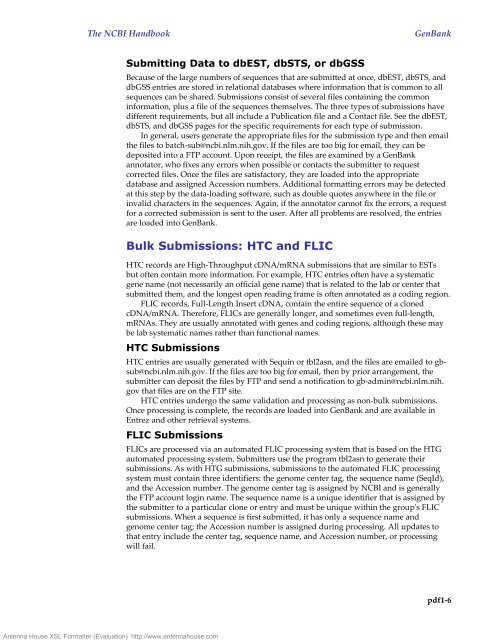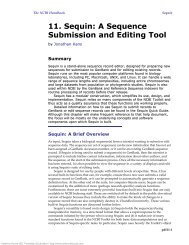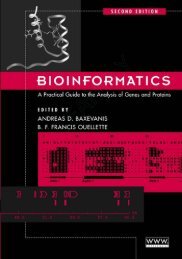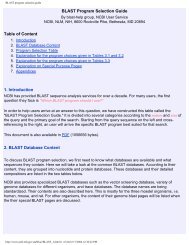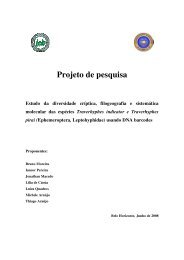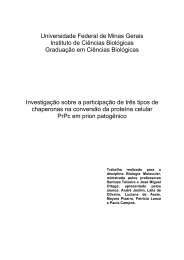1. GenBank: The Nucleotide Sequence Database
1. GenBank: The Nucleotide Sequence Database
1. GenBank: The Nucleotide Sequence Database
Create successful ePaper yourself
Turn your PDF publications into a flip-book with our unique Google optimized e-Paper software.
Antenna House XSL Formatter (Evaluation) http://www.antennahouse.com<br />
<strong>The</strong> NCBI Handbook<br />
<strong>GenBank</strong><br />
Submitting Data to dbEST, dbSTS, or dbGSS<br />
Because of the large numbers of sequences that are submitted at once, dbEST, dbSTS, and<br />
dbGSS entries are stored in relational databases where information that is common to all<br />
sequences can be shared. Submissions consist of several files containing the common<br />
information, plus a file of the sequences themselves. <strong>The</strong> three types of submissions have<br />
different requirements, but all include a Publication file and a Contact file. See the dbEST,<br />
dbSTS, and dbGSS pages for the specific requirements for each type of submission.<br />
In general, users generate the appropriate files for the submission type and then email<br />
the files to batch-sub@ncbi.nlm.nih.gov. If the files are too big for email, they can be<br />
deposited into a FTP account. Upon receipt, the files are examined by a <strong>GenBank</strong><br />
annotator, who fixes any errors when possible or contacts the submitter to request<br />
corrected files. Once the files are satisfactory, they are loaded into the appropriate<br />
database and assigned Accession numbers. Additional formatting errors may be detected<br />
at this step by the data-loading software, such as double quotes anywhere in the file or<br />
invalid characters in the sequences. Again, if the annotator cannot fix the errors, a request<br />
for a corrected submission is sent to the user. After all problems are resolved, the entries<br />
are loaded into <strong>GenBank</strong>.<br />
Bulk Submissions: HTC and FLIC<br />
HTC records are High-Throughput cDNA/mRNA submissions that are similar to ESTs<br />
but often contain more information. For example, HTC entries often have a systematic<br />
gene name (not necessarily an official gene name) that is related to the lab or center that<br />
submitted them, and the longest open reading frame is often annotated as a coding region.<br />
FLIC records, Full-Length Insert cDNA, contain the entire sequence of a cloned<br />
cDNA/mRNA. <strong>The</strong>refore, FLICs are generally longer, and sometimes even full-length,<br />
mRNAs. <strong>The</strong>y are usually annotated with genes and coding regions, although these may<br />
be lab systematic names rather than functional names.<br />
HTC Submissions<br />
HTC entries are usually generated with Sequin or tbl2asn, and the files are emailed to gbsub@ncbi.nlm.nih.gov.<br />
If the files are too big for email, then by prior arrangement, the<br />
submitter can deposit the files by FTP and send a notification to gb-admin@ncbi.nlm.nih.<br />
gov that files are on the FTP site.<br />
HTC entries undergo the same validation and processing as non-bulk submissions.<br />
Once processing is complete, the records are loaded into <strong>GenBank</strong> and are available in<br />
Entrez and other retrieval systems.<br />
FLIC Submissions<br />
FLICs are processed via an automated FLIC processing system that is based on the HTG<br />
automated processing system. Submitters use the program tbl2asn to generate their<br />
submissions. As with HTG submissions, submissions to the automated FLIC processing<br />
system must contain three identifiers: the genome center tag, the sequence name (SeqId),<br />
and the Accession number. <strong>The</strong> genome center tag is assigned by NCBI and is generally<br />
the FTP account login name. <strong>The</strong> sequence name is a unique identifier that is assigned by<br />
the submitter to a particular clone or entry and must be unique within the group's FLIC<br />
submissions. When a sequence is first submitted, it has only a sequence name and<br />
genome center tag; the Accession number is assigned during processing. All updates to<br />
that entry include the center tag, sequence name, and Accession number, or processing<br />
will fail.<br />
pdf1-6


